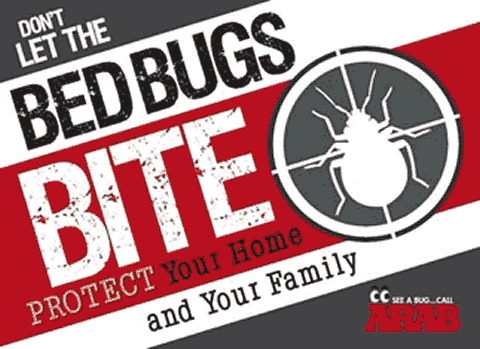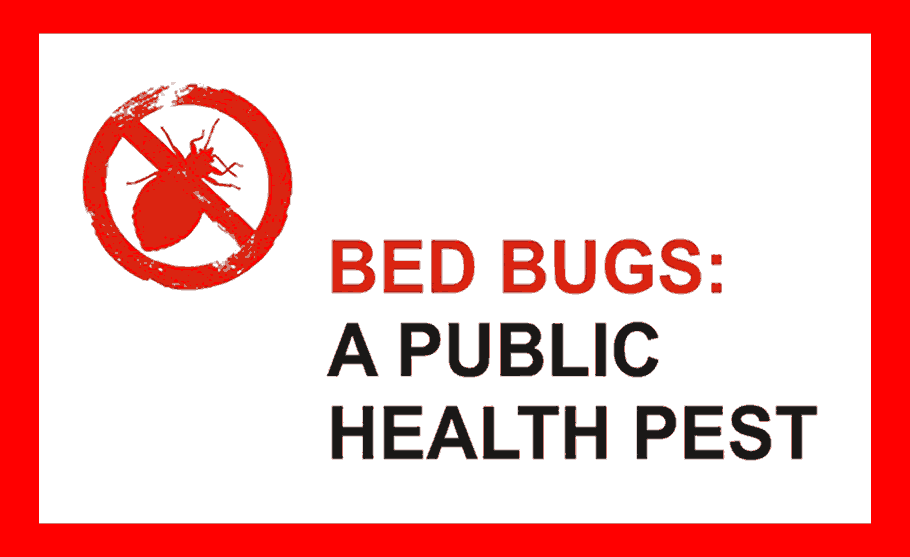Spiders
| Class: Arachnida | |
| Order: Araneae | |
| Common Name | Family |
| Cobweb Spiders | Theridiidae |
| Orb Weaver Spiders | Araneidae |
| Funnel Web Spiders | Agelenidae |
| Cellar Spiders | Pholcidae |
| Wolf Spiders | Lycosidae |
| Jumping Spiders | Salticidae |
| Nursery Web Spiders | Pisauridae |
| Crab Spiders | Thomisidae |
Information provded by Ohio State University.
Many people are afraid of spiders. This fear is partly due to myths and to the notoriety of harmful species such as the brown recluse spider and the black widow spider. Several species of sac spiders (clubionids) are suspected of being responsible for most spider bites, especially ones occurring indoors. Sac spider venom is cytotoxic, causing tissues at the bite site to die. However, the vast majority of spiders are harmless to humans.
Although spiders are often unpopular, the venom of most species is not very toxic to humans, usually resulting in no more than a slight swelling, inflammation, or itching sensation. Most spiders fangs are too small or weak to puncture human skin. Spiders usually will not attempt to bite unless accidentally trapped against the skin or grasped, although some species actively guard their egg sacs or young.
Spiders are beneficial predators that reduce pest populations (flies, crickets, mites, etc.) in and around homes, yards, gardens, and crops. Wholesale destruction of spiders should be avoided.
Identification
Spiders have eight legs (four pairs). They have two body regions: a cephalothorax (fused head and thorax) and an abdomen, which are joined together by a narrow waist. Most spiders have six or eight simple eyes in various arrangements. All have a pair of jaw-like structures, the chelicerae, each of which ends in a hollow fang through which venom can be ejected. The tip of the abdomen has a group of small fingerlike spinnerets that produce silk. Young spiders (spiderlings) resemble adults except for their smaller size and coloration.
Life Cycle and Habits
Spiders lay eggs within a silken egg sac that is often ball-shaped and either hidden in a web, affixed to a surface, or carried by the female. Spiders may produce several egg sacs, each containing up to several hundred eggs. A spider grows by shedding its skin (molting), usually four to twelve times before maturity. In many species, the mature male often wanders about in search of a mate. Some species of spiders may live for years, but most spiders only survive for one season.
All spiders produce silk, which is secreted as a liquid through the spinnerets and hardens on air contact. Spiders use silk for a variety of purposes, such as making egg sacs, capturing prey, holding prey, making shelters or retreats, and transferring sperm during mating. Also, spiderlings extrude silk threads that enable them to be transported by air currents, a process called "ballooning."
Spiders are predators that typically feed on living prey. They produce venom that is poisonous to their normal prey of insects, mites, and other small arthropods. Venom is injected through the hollow fangs to immobilize the prey and begin the digestion process. Spiders can only ingest liquids, so they either inject or regurgitate digestive fluids into the prey. They then suck in the digested liquid food.
Spiders use a variety of tactics to capture prey. Some species are web builders that use webbing to ensnare their prey. Others are active hunters that actively search for their prey. Passive hunters are spiders that lay in wait for their prey rather than searching for it.
Spiders Commonly Associated with Structures
Web Builders
Many spiders use webbing to ensnare their prey. Their web designs vary and may or may not be elaborate. Web-builder spiders discussed here include cobweb spiders, orb weaver spiders, cellar spiders, and funnel web spiders.
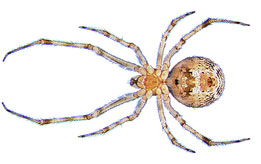
Cobweb Spiders
The web building habits of cobweb spiders contribute to their pest status. These spiders typically construct an irregular web in sheltered sites indoors or outdoors. The outer sticky threads of the web entangle insect prey. These spiders often are inconspicuous, although their web is not. Some species construct a retreat within the web and hide therein during the day, and the spider hangs upside down in the center of the web at night.
Cobweb spiders, including widow spiders, belong to the family Theridiidae and have a rounded globular abdomen (black widow spider shape). One member of this family, the common house spider (Achaearanea tepidariorum) is about 1/3 inch long (female), gray to brown, and its spherical abdomen has several dark stripes near the tip. The common house spider requires high humidity and plentiful prey; it typically occurs in damp basements, cellars, crawl spaces, and outbuildings. This species frequently abandons webs that do not yield prey, and then constructs new ones until it finds a productive site. Webs become dust covered when abandoned.
Orb Weaver Spiders
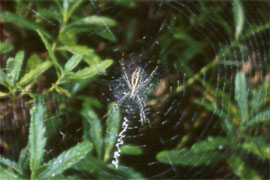
Orb weaver spiders construct the familiar circular, flat, elaborate web in which flying insects are trapped. Each species of orb weaver typically constructs a web with a distinctive design. Webs usually occur outdoors. These spiders have poor vision and locate their prey by feeling the vibration and tension of the threads in their web. They use silk to wrap the victim.
Many species of orb weaver spiders are large (approximately 1 inch), but others are quite small (approximately 0.1 inch). Some have oddly shaped abdomens (pointed spurs, conical tubercles, etc.). Some are very brightly colored. One common spider, known as the yellow garden spider (Argiope aurantia), has silver hairs on the back of the cephalothorax and a large abdomen marked in black and bright yellow or orange. This spider is about 1 inch long and hangs head down in the center of the web, which is found in brambles, bushes, tall grasses, etc. in open sunny places.
Despite their formidable appearance, orb weaver spiders are not considered dangerous. Some species can bite if handled.
Cellar Spiders
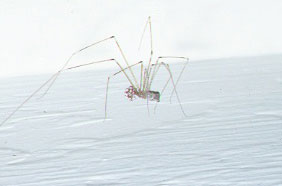
Cellar spiders are frequently found in dark, damp places such as cellars, basements, crawlspaces, and outbuildings. They typically construct a loose, irregular-shaped web in a dark corner. Cellar spiders continually add to their web, which can result in extensive webbing. The male and female live together in a web and can be found hanging upside down in it. They shake the web violently when alarmed. Cellar spiders can quickly establish large populations in a structure.
Cellar spiders have very long, slender legs (up to 2 inches long). Their body is about 1/3 inch long and pale colored (whitish-yellow to gray). They are sometimes confused with daddy-long-legs.
Funnel Web Spiders
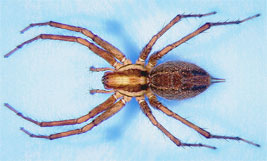
Funnel web spiders construct large, flat, horizontal webs of nonsticky silk. The web contains a funnel at one end that serves as the spider's retreat. The funnel is open at both ends so the spider can readily escape. The spider hides at the narrow end of the funnel; when it feels the vibration of an insect crossing the web, it dashes out, bites the insect, then carries it back to the funnel. In former times, the silk of funnel web spiders was used to cover wounds to stop bleeding.
Funnel web spiders generally are brown and somewhat large (>1/2 inch long). Some species have banded legs. Some species have long spinnerets that extend out beneath the rear of the abdomen.
In the family Agelenidae, some species of Agelenopsis (grass spiders) and nonnative Tegenaria (house spiders) will infest structures, but their webs typically are confined to the lower levels. The hobo spider, Tegenaria agrestis, was introduced from Europe and is found in parts of the Pacific Northwest. The hobo spider is known to bite humans, and its venom has similar effects to that of the brown recluse spider. Hobo spider bites are probably from the males, which wander in search of female mates. The bites of other funnel web spiders are not known to be very toxic to humans.
Active Hunters
Some spiders actively search for their prey. Any webs that they construct are used as resting areas. These spiders are commonly encountered when they venture from their retreat to search for prey. Spiders discussed herein that actively hunt include wolf spiders, jumping spiders, and nursery web spiders.
Wolf Spiders
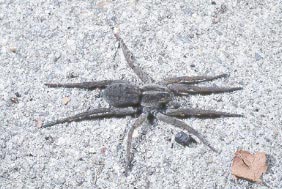
These hunting spiders are fast runners that will chase their prey. Wolf spiders are hairy and often large, up to 1-3/8 inches long, sometimes confused with tarantulas. Their legs are long and spiny. Many are dark brown.
Wolf spiders may hunt day and night. They usually occur outdoors, but may wander indoors in search of prey. They tend to stay at or near floor level. They typically construct web retreats in sheltered sites.
Females carry their large, globular egg sac attached to spinnerets under the abdomen. Upon hatching, the spiderlings climb onto their mother's back and stay there several days or more before dispersing.
Wolf spiders frequently alarm homeowners because of their large size and rapid movements. Wolf spiders are not aggressive, but may bite if handled.
Jumping Spiders
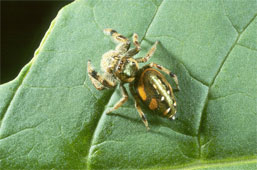
These spiders are so named because of their jumping ability. They can jump many times their own length. They make quick, sudden jumps to capture prey or avoid a threat. They also can walk backward.
These common spiders are about 1/8 - 3/4 inches long, very hairy, stocky built, and short-legged. Two of their eight eyes are very large. They have the keenest vision of all spiders. Many species have patches of brightly colored or iridescent scales. Some are black with spots of orange or red on the upper surface of the abdomen, at times confused with black widow spiders.
Jumping spiders are active during the day and prefer sunshine. They normally live outdoors, but jumping spiders can become established indoors and their hunting activities often center about windows and entry doors where their prey is most common.
Nursery Web Spiders
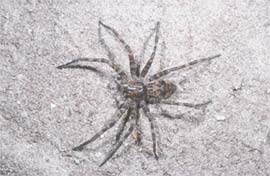
These spiders attract much attention due to their large size as they can have a leg span of 3 inches. Many are earth tone colored.
Nursery web spiders typically live near lakes and streams, but occasionally are found indoors in moist areas. Many can run over the surface of water and, if chased, dive and stay submerged for some time. They hunt day and night for aquatic insects and even small fish. They are sometimes commonly called fishing spiders.
The sole use of their silk webbing is for the egg sac. The female uses her mouthparts to carry the egg sac under her body until the spiderlings are ready to emerge. She then fastens the egg sac to some leaves and encloses it within a "nursery" web, where the spiderlings remain until they are ready to disperse. The female stands guard near the nursery web to protect her young.
Passive Hunters
Passive hunters are spiders that lay in wait for their prey rather than searching for it. When their prey approaches, they may jump or pounce to seize it. Crab spiders are the only passive hunters discussed here, although tarantulas and many other spiders employ this technique to obtain food.
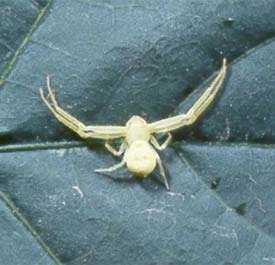
Crab Spiders
These spiders have a flattened body and hold their legs at right angles to their sides, presenting a crablike appearance. They can walk forward, backward, or sideways.
Many crab spiders have horns or ornaments on the cephalothorax or abdomen, and some mimic bird droppings. Those that inhabit trees or hunt on the ground are usually colored with shades of gray, brown, or black, while those that frequent flowers are bright red, yellow, orange, white, and/or green.
Spider Relatives
The class Arachnida includes spiders and some other arthropods that are closely related to them. Close relatives of spiders are found in 10 orders and include scorpions, pseudoscorpions, mites, ticks, and daddy-long-legs (also called harvestmen). Daddy-long-legs are very commonly confused with spiders due to their general appearance and eight legs, but these tan to brown creatures belong to the order Opiliones and are not spiders.
Contact Us ~ We can help!
Hours of operation: Monday through Friday 7:30 A.M. to 4:00 P.M. EST
Arab Pest Control, a division of Lewellen Services, Inc.
232 West Main St., Logan, OH 43138
800-654-8870
![]()
![]()


![]()
Serving Central And Southeastern Ohio Since 1980 • Family Owned And Operated• Fully Licensed By The State And Bonded And Insured. • Termite Warranties • Licensed Technicians • Extensive Training and Retraining• Uniformed Technicians• Marked Vehicles• All Pest Services Offered• Able To Tailor Services To Fit Your Needs• Convenient Hours• Polite And Courteous Staff • We Use The Up To Date Chemicals And Treatment Methods To Protect Your Family And Pets • Many Treatment Services Offered• Senior Citizen Discounts



